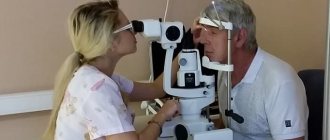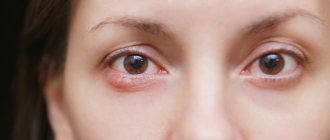Ophthalmologist, Laser ophthalmic surgery
Karapetyan
Arevik Samvelovna
7 years experience
Ophthalmologist
Make an appointment
Acute purulent inflammation in the hair follicle of the eyelash or in the sebaceous gland is called “barley” because of its characteristic round shape, reminiscent of grain. The external harmlessness of this phenomenon is deceptive: it clearly indicates a decrease in the protective properties of the immune system and requires careful treatment to prevent relapses and possible complications.
Causes of stye on the eye
Staphylococci, which prefer to settle on human skin and hair, do not manifest themselves in any way with strong immunity. Their intensive reproduction is triggered by a decrease in the protective properties of the body, its hypothermia, severe illnesses and hypovitaminosis, and the consequences of helminthic infestation. Penetrating into the structure of the hair follicle, streptococci cause inflammation and suppuration as a reaction to a pathogenic microorganism. This is the main cause of stye on the eye in patients of all ages. With an unbalanced diet, increased physical activity or stressful situations, the disease can occur in the form of several or multiple suppurations on the eyelids or mucous membranes. Also among the factors contributing to the appearance of stye on the eye is the habit of touching the eyelids with dirty hands, a large amount of dust indoors or outdoors.
The risk group for the likelihood of the appearance of barley includes:
- patients with reduced immunity;
- persons with diseases of the endocrine system;
- patients with gastrointestinal pathologies;
- persons whose professional activities involve working outdoors or in premises with difficult climatic or unsanitary conditions;
- patients who have suffered inflammatory diseases of the eyes and eyelids, as well as those who have not completed the prescribed course of treatment.
Rating of ointments for barley
Much work has been done to understand which medications are effective against barley. The editors of the magazine consulted with leading doctors, got acquainted with the clinical trials of various drugs, and studied patient reviews. Each applicant was assessed on the following group of criteria:
- Composition – natural, synthetic, hormonal;
- Effect – anti-inflammatory, antimicrobial, analgesic;
- Speed of action - how quickly relief will come;
- Rules of application - frequency of application, duration of course;
- Indications - a list of problems that the ointment solves;
- Limitations – a list of symptoms when treatment is unacceptable;
- Risks – the likelihood of developing undesirable reactions to the composition;
- Texture – lightness, fat content, absorption rate, smell;
- Age indications - from what age is use allowed;
- Special instructions – pregnancy, lactation.
As a result of the investigation, available, effective, safe eye ointments for stye were identified. Those that have a large list of contraindications, side effects, as well as unreasonably expensive medications are excluded from the list. Reviews and expert opinions played an important role.
The best drops for barley
Symptoms of stye on the eye
Suppuration of the eyelid makes itself felt by a feeling of heaviness, swelling and inflammation along the eyelash line. The area becomes painful, the temperature of the skin of the eyelids rises. The line of edema has clear boundaries; signs of hyperemia are noticeable on the conjunctiva - redness and inflammation. Within 2-3 days from the moment the barley develops, a purulent head forms on its surface, the contents of which are dead cells of the hair follicle.
With internal barley, the pathology is localized in the area under the eyelid - in the so-called meibomian gland, which makes the disease almost invisible. The inflammatory process is indicated by the characteristic symptoms of stye - thickening and soreness of the affected eyelid. The danger of such a disease is the development of chalazion - inflammation of the cartilage around the meibomian gland, which significantly delays the healing process and forces the patient to undergo regular examinations by an ophthalmologist.
In severe cases, with barley localized inside the sebaceous gland, signs of general intoxication are observed - headache and muscle pain, fever, swollen lymph nodes. Self-medication in this case is strictly contraindicated, and the patient should immediately seek medical help.
Are you experiencing stye symptoms?
Only a doctor can accurately diagnose the disease. Don't delay your consultation - call
How to choose an ointment for barley
Stye is a fast-growing process that requires the use of medications. Usually these are medications for external use - ointments, drops, creams, solutions. Pharmacy chains stock dozens of domestic and imported products. The correct decision on which ointment to treat barley is made by the doctor. The composition decides a lot, narrowing down the search for contraindications and prices.
Specialist consultation
Self-medication during an acute inflammatory process is fraught with suppuration and secondary infection of tissues. In addition, the eyes are located nearby. Therefore, self-medication is unacceptable; to prescribe medications, consult an ophthalmologist. He conducts an examination, after which he selects a safe but effective drug.
Components
To treat the inflammatory process on the eyelid, different compounds are used - antibiotics, antiviral, antimicrobial, antihistamine, regenerating components. Only an ophthalmologist can correctly determine the cause and type of pathogen, on the basis of which suitable components are selected.
Contraindications
Almost all pharmaceutical products have contraindications for use. Based on this, unsuitable options are immediately eliminated, narrowing the search range. Antibiotics are not acceptable for hypersensitivity, pregnancy, or lactation. Antiviral medications for liver pathologies. Natural compositions are the safest and most versatile.
Price
Pharmacy chains offer Russian-made drugs, which are available to most buyers. You will have to pay more for European quality and brand reliability. Most modern medicines are available in three types to choose from: a patented original drug, a domestic analogue, and a generic.
Types and stages of development of barley
Depending on the location and external signs there are:
- External stye is a painful formation on the eyelash line that quickly festeres. Signs of barley in this case are visible to the naked eye, which simplifies the diagnosis;
- internal barley - localized inside the eyelid, causing discomfort due to severe pain and the feeling of a foreign object in the eye. It is detected during a visual medical examination.
The formation and development of barley occurs in several stages:
- infiltration process. The first characteristic signs of suppuration appear: itching, swelling, redness of the eyelid in the area of inflammation. Over the course of several hours, the discomfort intensifies;
- process of suppuration. A capsule with purulent contents is visible on the surface of the formation. With an increase in the volume of pus or mechanical impact, it may break out prematurely;
- the process of breakthrough of the purulent capsule. If the inflammation does not break out on its own, it is opened by a surgeon. Separation of purulent contents occurs within several days;
- healing. A crust forms at the site of the ulcer, under which a thin layer of restored skin forms. Depending on the quality of the course of treatment and the state of the immune system, the healing period can range from several days to several weeks.
Complications of stye on the eye
The importance of seeing a doctor when barley appears is due to the high risk of developing the following complications:
- conjunctivitis is an infectious lesion of the mucous membrane of the eye, causing swelling, hyperemia and some blurring of vision. Treatment of the disease is complex and lengthy;
- Chalazion is a cystic formation on the inside of the eyelid. Causes inconvenience and requires long-term treatment;
- phlegmon of the orbit - caused by profuse suppuration due to an attempt to independently open the stye or multiple formation of foci of suppuration with their subsequent fusion. Symptoms of this pathology are blurred vision, severe swelling, discomfort when moving the eyelid, etc.;
- thrombosis of the vascular plexus - a violation of the outflow of fluid from the orbit, which causes swelling. The eyeball protrudes, the skin turns blue, the eyelids become inflamed, and vision deteriorates sharply;
- thrombophlebitis is an inflammatory process in blood vessels. Characterized by headache, feeling of fatigue, decreased visual acuity, redness of the eye mucosa;
- meningitis - consequences of phlegmon of the eye. Signs of a deadly pathology: temperature above 39°C and severe headache;
- sepsis is blood poisoning due to the ingress of pus and pathogenic microorganisms into it. Signs of complications: intoxication of the body, chills, rapid heartbeat, rash, breathing problems.
Which ointment for barley is better
The editors of VyborExpert considered several dozen candidates for inclusion in the top review. But we selected time-tested, doctor-approved ointments that really help and received the most positive reviews. What to buy will be suggested by the summed up results of the comparative analysis:
- Tetracycline ointment is an ambulance for the treatment of any diseases of the eyelids and eyes;
- Acyclovir – suppresses the virus, increases local immunity, restores tissue;
- Hydrocortisone ointment – hormonal ointment for quick recovery;
- Levomekol - antibacterial liniment for all ages, pregnant women;
- Floxal is a universal antibiotic from the fluoroquinolone group;
- Erythromycin ointment is the broadest spectrum of action of a macrolide antibiotic.
Stye is a common problem that can appear at any age. To prevent complications, a suitable local medication is used in a timely manner. You can be guided in your search by the criteria and recommendations of the presented review, but the last word should always belong to the ophthalmologist.
Treatment of barley
With strong immunity, the disease can go away on its own without special treatment. This happens if the adverse effects on the body have stopped and the activation of staphylococcus has been suppressed.
Self-treatment of stye on the eye with medications at home is not recommended. Moreover, folk recipes often pose a threat to vision. Tips on how to treat stye can cause rupture of the purulent capsule and infection of the eye mucosa with the most serious consequences.
A course prescribed by a specialist will be many times more effective and safer. Its components are antibacterial drugs, local antibiotics and compounds for relieving the inflammatory process. Treatment of barley should be carried out under supervision and based on the recommendations of a specialist. If a complication develops, he will immediately correct the course and take measures to prevent further inflammation.
Prevention of stye
The following will help eliminate the risk of stye:
- compliance with personal hygiene rules;
- measures to strengthen the body's defenses and restore immunity;
- eliminating situations of overheating or hypothermia of the body;
- timely treatment of serious infectious diseases;
- active lifestyle;
- balanced diet, taking vitamin courses.
Additional recommendations taking into account the patient’s body condition will be given by the attending physician.
Postoperative period
Treating barley surgically does not take much time: a specialist opens the abscess and washes the wound. For rapid healing, fighting infection, pain relief, etc., the doctor may prescribe anti-inflammatory drugs, antibacterial drops and ointments. Helping the treated eye with medications is also indispensable. And any non-compliance with the doctor’s recommendations sometimes even provokes the spread of infection, so you should take your health seriously. In some situations, you will have to visit the hospital regularly until the wound is completely healed: the surgeon will process its edges and apply lotions. This will avoid tissue scarring and maintain a beautiful, fresh look.
Questions and answers
What causes stye on the eye?
The main cause of inflammation is infection of the sebaceous gland or hair follicle of the eyelash due to the active activity of staphylococci. This is facilitated by air pollution, a decrease in the protective properties of the immune system, and non-compliance with personal hygiene rules. Less commonly, stye appears on the eye due to difficult professional conditions or untreated infectious eye diseases.
How does stye appear?
The first signs of stye are discomfort of the eyelid, noticeable inflammation and swelling of the eyelash area, itching and a feeling of some heaviness. Within a few days, a yellow, purulent head of inflammation becomes noticeable on the surface of the skin. As it matures, it breaks through, after which a number of “inflammatory” symptoms of the disease go away, but a slight itching and an area of redness remain.
How to quickly remove stye from the eye?
Any methods of treating stye should be agreed upon with an ophthalmologist. The sooner you seek help, the faster you will be able to cope with the pathology. Antibacterial agents and topical ointments will help speed up the breakthrough of the purulent capsule. Attempts to quickly remove stye from the eye with compresses, heating or squeezing out pus are very dangerous and can cause serious inflammation of the mucous membrane and damage to the eyeball.
Causes
Most people believe that internal stye of the upper eyelid occurs due to local or systemic hypothermia. Undoubtedly, this factor plays a role in reducing immunity, but the direct cause of barley in this case is infection of the meibomian gland duct with bacterial cells.
Among the causes of upper internal styes, mention should be made:
- Allergy phenomena;
- Violation of the rules for using contact lenses;
- Reduced immune defense factors;
- Hormonal changes in the body, especially during adolescence;
- Violation of hygiene procedures;
- Hypothermia and infection.
When immunity is reduced under the influence of various factors, the risk of proliferation of pathogenic microorganisms is much higher. At the same time, the ciliary hair bulb and the ducts of the sebaceous gland become very vulnerable to the influence of pathogenic microbes.
Disease prevention
To reduce the risk of developing internal styes of the upper eyelid, you should carefully monitor the condition of your eyes and follow all hygiene rules. You should not scratch your eyes with dirty hands, much less remove lenses. In windy weather, it is better to protect your eyes with sunglasses. You can also use eye massage, eat rationally, avoid drafts and hypothermia, take vitamin complexes and lead an active lifestyle.
In the medical department, everyone can undergo examination using the most modern diagnostic equipment, and based on the results, receive advice from a highly qualified specialist. The clinic provides consultations to children from 4 years old. We are open seven days a week and work daily from 9 a.m. to 9 p.m. Our specialists will help identify the cause of vision loss and provide competent treatment for identified pathologies.
You can find out the cost of a particular procedure or make an appointment at the Moscow Eye Clinic by calling Moscow 8 and (daily from 9:00 to 21:00) or using the online registration form.








